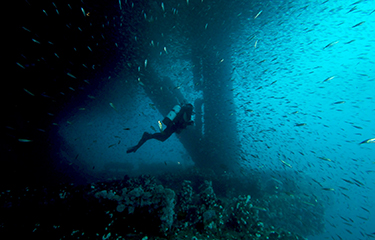Tens of thousands – hundreds of thousands, even – of rockfish, boccaccio, and lingcod congregate around the pillars of Southern California's 27 offshore oil platforms, while shellfish cling to them in thick mats.
The platforms near the Channel Islands are among the world's most productive hotspots for marine life, producing 27 times more total fish biomass than nearby natural rocky reefs, according to scientists, with rockfish making up 90 percent. From the surface, the platforms descend between 100 to 1,200 feet to the ocean floor; the height of the tallest is comparable to the Empire State Building.
Twenty-three of the platforms are in federal waters, and they are three to five decades old and in various states of operation and decommissioning. At least 10 are scheduled to be decommissioned by 2030, with the majority of the rest soon after.
With decommissioning, they would be removed, and the fish habitat erased.
Platform leases in federal waters expire one year after oil production stops, and decommissioning is supposed to take place a year after that. Though federal rules permit states to convert platforms to artificial reefs as long as the state takes ownership of the facility, California doesn't have an acceptable rig-to-reef program that would enable it, though the state’s 2010 Marine Resources Legacy Act could be amended to allow it.
"It's an opportunity that will disappear unless we amend the existing artificial reef program in California," Aquarium of the Pacific President Jerry Schubel told SeafoodSource. The aquarium held a forum on the oil platforms earlier this year, and issued a report afterwards. "Right now, the only option you have is to remove it entirely."
Louisiana and Texas have already decommissioned more than 500 platforms in the Gulf of Mexico and converted them to reefs. About 10 percent of all platforms in the Gulf have been reefed, including more than 85 percent of platforms deeper than 200 feet. All told, the United States has about 2,700 offshore oil platforms in federal U.S. waters, with another 1,000 in state waters.
Four of the platforms are in state waters within three miles of shore, and the state already possesses two of them, since the oil companies that owned them declared bankruptcy. But to take over the federal platforms, the state would need to establish an artificial reef program.
Fishermen have historically chafed at the platforms’ presence. They pose navigational hazards and limit fishing grounds since vessels must keep a certain distance from the platforms for security reasons. If vessels do get too close, nets and lines can snag on the underwater architecture – a hazard that would remain if the platforms were only partially removed.
But as the conversation over removal has amplified, the potential benefits of the platforms are growing more clear.
Rockfish and other species are likely to spill over from the platforms and take up residence in natural reefs where fishermen can catch them. As much as 20 percent of the yearly abundance of some rockfish species throughout their entire range can be attributed to the platforms. Additionally, a portion of the money saved by leaving the platforms in place would go to an endowment that could fund fisheries management, aquaculture, research, and other programs.
"There are definitely some folks who feel the platforms should be taken out because they're taking away fishing grounds, but some folks say it would be worse to take them out," Commercial Fishermen of Santa Barbara Executive Director Kim Selkoe told SeafoodSource. "If these rigs are performing as essential fish habitat, why would you destroy them? They're already sort of off-limits to fishing, so they're a potential exporter of fish.”
Drift gillnet fishermen, who are under immense pressure from environmentalists in California, generally want the platforms removed, Selkoe added. Groundfish fishermen, who are reaping the benefits of a rebounding West Coast stock, are more supportive of converting the platforms to reefs.
"The future is very bright for groundfish and there is more opportunity for groundfish, compared to drift gillnetting, which is a constant battle to keep going because of environmental pressures in California," Selkoe said.
The platforms could also host aquaculture operations, which would contribute to the local seafood economy. Local fishermen generally support shellfish aquaculture, but oppose finfish aquaculture because of the possibility of disease transmission, escapes, and a flood of cheaper product depressing prices, Selkoe said.
"Maybe sometimes it's better to leave the rigs in the water," Selkoe said. "You're weighing different risks and potential benefits that could come from the economic opportunities to keep our ports thriving if these were repurposed."
The vertical nature of the platforms seems to play a crucial role in the productivity of the ecosystem they host, allowing fish to grow through all life stages in one place.
The shallower reaches provide a nursery for the youngest fish, which then move down the platform as they grow older, according to scientists. The fish at the platforms’ bases are larger and more abundant than at natural reefs. As they age, some fish likely migrate away from the platforms to deeper natural reefs.
"Then they're potentially moving away, which is potentially a good thing for fishermen," California State Polytechnic University Professor Jeremy Claisse told SeafoodSource. "You have all this habitat up in the water column where you find a lot of young rockfish coming and living and growing up and living before they move down the platform. You have this renewal of young fish growing up and sustaining this population of large adults at the bottom."
Claisse has analyzed more than two decades of data on marine life around the platforms collected by researchers diving and piloting submersibles around the platforms and surrounding habitat areas. By converting data on fish numbers and size, Claisse has generated estimates of biomass production that he has compared to the productivity of natural rocky reefs in the area, along with other marine ecosystems.
"We knew there were a lot of fish on these platforms, but when you add it all up and you get the total amount of weight, it's as high as any other marine ecosystem that's been studied," Claisse said.
Photo courtesy of Ken Kurtis, Reef Seekers Dive Co.







